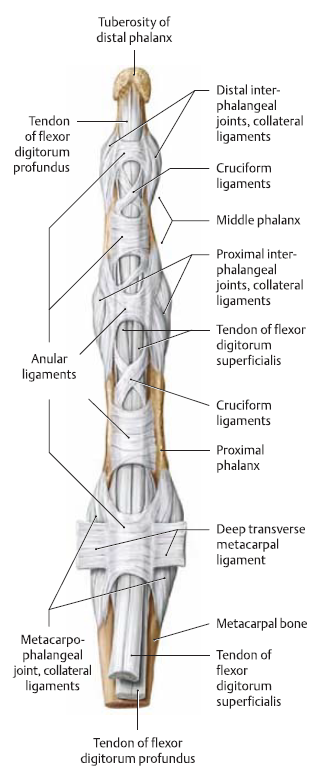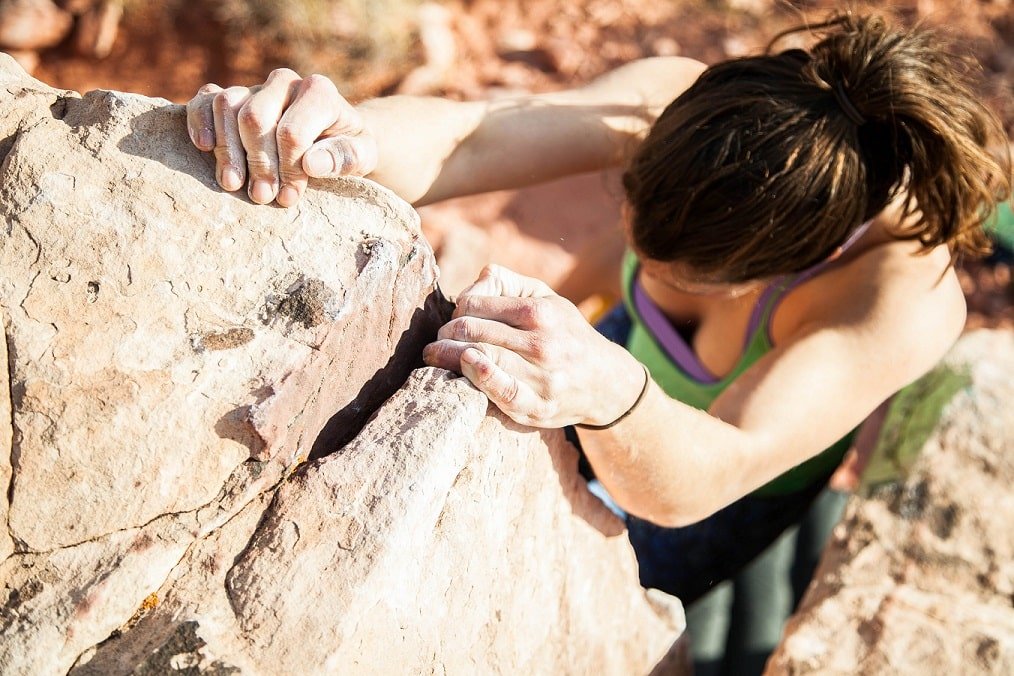The quickest way to heal arthritis in your fingers from rock climbing is to start by giving them rest for 2 weeks. After that, start loading the affected finger joints gradually until all pain in rest is gone. Then, when you’re 6 weeks into your rehab you can start climbing more and increase hang board intensity. This should all be done with baby steps and with sufficient rest between training moments to ensure that your joints can heal to a higher level.
Arthritis in your fingers can be painful and limit your climbing. Arthritis takes 12-16 weeks to heal, so don’t force your painful fingers and take a break sooner rather than later.
The rehab of finger arthritis is nuanced and there are plenty of details to consider. Before I share these with you though, we’ll look at what a finger joint looks like and what arthritis is.
So, let’s get on with it and get those fingers of yours ready for climbing again.
1. What Does a Joint in Your fingers Look Like?
Each joint consists of multiple parts. The main 5 are:
- Bones, articulating with each other;
- Cartilage, covering the surface of the ends of the bones making up the joint to protect it and absorb shock forces;
- Capsule & Ligaments, keeping the joint together, containing the synovial fluid, and limiting range of motion;
- Synovial Fluid, the lubricant or oil of the joint making sure it runs smoothly. Also responsible for slight shock absorption;
- Some joint capsules are directly connected with the pulley system.

2. Different Types of Arthritis
Arthritis comes from the word articulation (joint). The suffix -itis refers to inflammation. So, arthritis is inflammation of a joint.
As you’ve seen in the images above, a joint is made up of different parts. In the case of arthritis one or more structures might be affected. Arthritis may or may not originate from an acute training overload.
A quick Google Search into arthritis might end you up on pages describing other types of arthritis than the one that you’re suffering from.
The two most common ones are:
- Osteoarthritis is an auto-immune disease that diminishes proteoglycans, the water-containing proteins in your joint cartilage. As a result, your cartilage can retain less water and gets less spongy. Which in turn can lead to cartilage damage, pain, and inflammation. It’s the most common musculoskeletal disorder world-wide. You’re more likely to develop osteoarthritis when you’re between the ages of 40-60, did a lot of sports or none at all during your life, when you’re overweight, and when it runs in the family.1 In worse cases, osteoarthritis can lead to (chronic) arthritis.
- Rheumatoid Arthritis is an autoimmune disease with an unknown origin. It usually comes on between the age of 30-50, usually in the fingers, hands, toes, and feet. Typically, on both sides of the body with the first signs often being swollen, stiff, and painful joints.2
So, what is going on in your case? Which structures are involved when you develop an acute bout of arthritis after climbing?
You’re likely experiencing:
- Capsulitis; an inflammation of the joint capsule;
- Synovitis, an inflammation of the synovial fluid within your joints
You can distinguish these types of arthritis from osteoarthritis and rheumatoid arthritis by becoming aware of their origin.
3. How Did You Get Arthritis in Your Fingers?
In a recent blog, I discussed the reason your fingers are hurting from climbing. In there I explained how repetitive microtraumas can turn into injuries.
If you developed arthritis because of climbing that’s most likely what happened.
You climbed a lot (more than before), took too little rest between climbing sessions, or had a sudden increase in non-climbing activities which affect your hands and fingers. All of these things can increase the chance of arthritis in your fingers due to repetitive microtrauma.
The best way to see microtrauma’s in your joints is to compare them with Delayed Onset Muscle Soreness (DOMS), the official name for sore muscles after working out. Due to training micro-traumas occur in your muscles. Your body responds by healing these and making your muscles stronger so that you’ll be ready when you do the same training again.
The same happens with joint capsules, tendons, pulley systems, and ligaments. The thing is though, these structures have a slow metabolism and thus respond slower to changes in training load.
As a result, you can overload your joints without noticing it right away. You keep climbing hard thinking you’re doing great. When all of a sudden…
You’re hurt. And you’ll think it’ll go away.
You just take some anti-inflammatory medication, rest for 2 days, and tape your fingers.
But you know what?
That’s not enough.
A slow metabolism means that healing takes longer too.
So please, if you notice arthritis in your fingers read on below to understand the best and most efficient way to climb pain-free again.
4. Healing Arthritis in Your Fingers
Healing arthritis goes through 3 gross phases.
- Acute phase 5 days-2 weeks: there’s an active inflammation going. This means that there’s redness, pain, swelling, heat, and a loss of function (reduced strength or mobility f.e.) in the affected joint(s). No climbing, no training.
- Sub-acute phase 2-6 weeks: inflammation is less present and your body starts to regenerate damaged structures. Start with light exercises to stimulate healing. Climbing is only allowed if you can entirely evade loading your injured joint.
- Chronic phase 6-12 weeks: the base of the healing is done, now it’s time to get your joints back to their original strength. Restart climbing depending on injury severity. And increase training load over weeks to pre-injury levels.
That’s a quick overview of the three healing phases. Below I describe in detail what you should do to heal your arthritis efficiently.
4.1 Step 1: Acute Phase [PROTECT]
The main theme of this healing phase is protection. This means: don’t climb, don’t train, put your feet up and relax.
Still, there are some things you can do to manage the inflammation in your joints:
- Put a light compression around to stimulate blood circulation and reduce swelling
- Ice a couple of times a day for up to 20 minutes each moment. Put ice in a plastic bag and then in a thin towel to evade direct contact with the skin
- In severe cases, anti-inflammatory drugs might be an option. Ask your doctor about this. And NEVER do this to keep climbing. You’re not feeling pain but your injury is not healing. So, you’re damaging your joints on top of the damage that’s already there.
Besides managing inflammation it’s good to keep moving your joints without loading them. The simplest way to do this is by just flexing and extending the fingers which are injured. Move until you feel pain, nothing more. Repeat these movements around 30 times 3-4 times a day.
Once there are no signs of inflammation anymore and you took rest for 14 days, you’re ready to move on to the next phase in your rehab.
4.2 Step 2: Sub-acute Phase [LOAD]
During the sub-acute phase, your body is actively repairing injured structures. Which means you want to stimulate it to heal correctly. The best way to do this is by applying a light load to the injured structures.
Capsules, ligaments, and tendons respond best to traction and stretch forces.
- Traction of the joint capsule is best done as shown in the video below. Do 30 small super-light pulls (oscillations).
- Passive stretching 3×60 seconds/day with 3/10 pain intensity
- Active movements against (more) resistance 30 repetitions 3-4 times a day
- Sub-maximal hangs building up from 15-30 second hangs. For 5-10 reps with a 1-minute break in between.
- From week 4-5 on climbing on positive open holds at least 2 grades below your onsight grade. You should be able to climb fluently and totally in control. Never climb 2 days in a row.
Climbing and sub-maximal hangs don’t result in pain that lasts longer than 24 hours, isn’t stronger than 3/10, and doesn’t provoke inflammation? Then you’re ready to move on to the last phase of your rehab.
4.3 Step 3: Chronic Phase [INCREASE & FORCE]
Week 6-8
- Passive stretching 3x60seconds/day with 5/10 pain intensity
- Sub-maximal hangs 10x30seconds/1-2xday with toes on the floor
- Climb on all holds 2 grades below your onsight grade. Never climb 2 days in a row.
Can you hang and climb pain-free or with a pain intensity of up to 3/10 which subsides right after you stop loading your fingers? Then, you can start pushing your climbing intensity gradually.
Week 9-12
Now is the moment to push yourself, but gradually. This stimulates the healing in your joints and ensures you’ll get back to your old climbing level. Do it too much though, and your rehab might last longer.
So, again, baby steps.
Progress during 4-8 weeks from:
- Sub-maximal hangs as mentioned above to maximal hangs of 3-6 seconds and repeaters
- From lead climbing 2 grades below your onsight grade to redpointing. Try to keep your climbing days apart to ensure proper recovery.
- After 12 weeks hard bouldering is up for consideration
- After 12 weeks climbing 2-3 days in a row can be done again, but as always manage your intensity. Choose the days you want to climb hard and focus on technique, endurance, and weaknesses on others.
5. Important Take-Aways
In this blog, I showed you how to heal arthritis in your finger efficiently. Remember though that this is the theory side of things and your needs might vary. It is not always that you need to stop climbing entirely. But it is also not always that your injury will be gone within 3 months. Are you unsure about your situation? Stay on the safe side and progress slower.
Furthermore, I’d like to repeat: protect your arthritic joints in the first weeks. When inflammatory symptoms are gone start loading slowly. And when after +-6 weeks your joints feel stronger and pain-free outside of training it’s time to load and force with baby steps to get your fingers back to their original strength.
Do you still have questions after reading this blog? Feel free to send me an e-mail at [enter e-mail] if you have any questions.
6. Citations
1. Pereira D, Ramos E, Branco J. Revista Científica da Ordem dos Médicos Osteoarthritis Osteoartrite. www.actamedicaportuguesa.com. Accessed July 27, 2021.
2. Kaushik P, Kaushik R. Diagnosis and Management of Rheumatoid Arthritis. Am J Med. 2008;121(6):1245-1252. doi:10.1016/j.amjmed.2007.11.026
